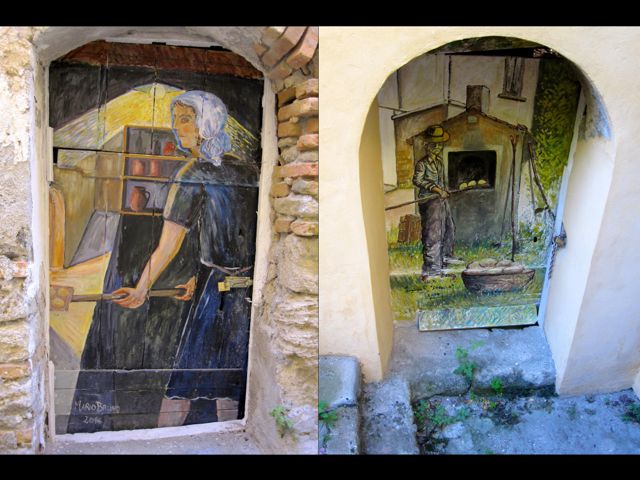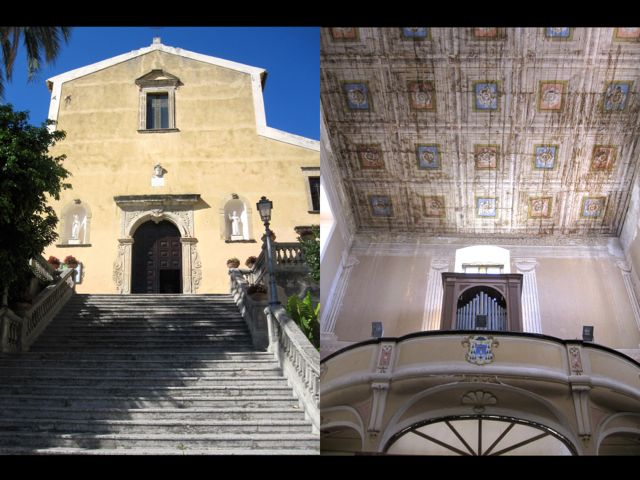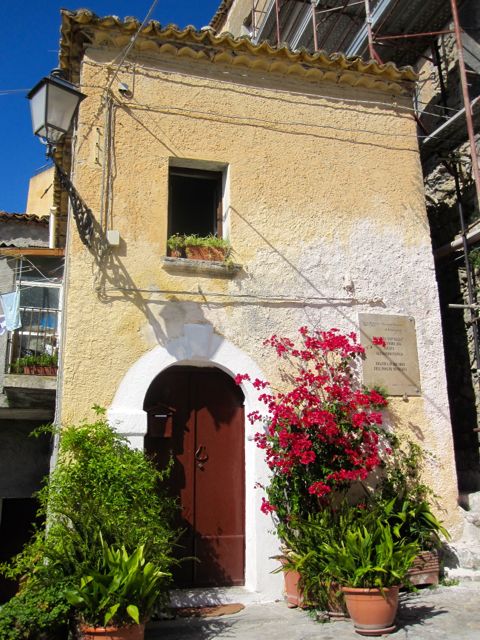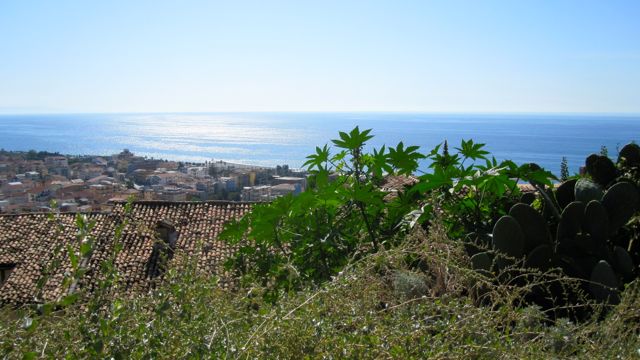THE BEACH
Amantea is blessed with an unusually mild climate, and that’s something Italians are really able to appreciate – good beach weather. In Amantea, summer can begin as early as April and last into November. Thus, the town’s long sandy beach is popular. In fact, Amantea boasts eight beautiful miles of shoreline along the Tyrrhenian Sea, a narrow coastal terrain, just a little over a mile wide before climbing the adjacent hillside.

Amantea Beach
Visiting Amantea last year in mid-October, I had the beach practically all to myself, although there was the lone Italian man, sure that fate had brought us together on that particular stretch of sand in that precise moment in time to share our eternal destiny. But that guy hangs out on many an Italian beach.
Off-season travel can be relaxing, peaceful even. With a last-minute telephone call I had a large, ocean view room, very comfortable temperatures, lots of elbowroom and lower prices. However, fewer services usually go hand in hand with less bustle, so the summer shuttles supplied by the town to ferry guests without a car from the beach hotels outside the center to the heart of Amantea won’t be available. There are bike paths along the beach and the proprietor of the hotel informed me that they would soon lead all the way to the urban center. (Perhaps they already do.) Rather than rely on the very enthusiastic beach guy for a lift downtown, I availed myself of the hotel’s front desk services.
A LITTLE BIT OF AMANTEA HISTORY
Amantea serves not only as a tourist hub in this southwest corner of the Province of Cosenza, but with its population of about 14,000 it is also a focal point for commerce and culture. As everywhere in Calabria, its history is long, and the shores of Amantea have witnessed many a battle and skirmish. Interestingly, while most of the region managed to resist persistent Arab attacks over the course of 1,000 years, Amantea was conquered twice. The first emirate lasted for 40 years during the 9th century and the second endured over 50 years, bridging the 10th and 11th centuries.

Castle Ruins in Amantea
Perhaps Amantea’s best-known conflict is the 40-day siege carried out by the French army against the resisting Bourbons in 1806-07 as part of Napoleon’s War of the Third Coalition. This struggle was the final blow for Amantea’s castle, which in addition to military damage had been hit hard by the devastating earthquakes of 1638 and 1783. The most recent attack on the community occurred in 1943, a bombardment at the hands of the Americans.
Today, the castle still dominates the very top of the hill above the town, but it is a ruin, a picturesque relic of Amantea’s history. The old village hugs the hill below the castle and more modern development continues down the slope to the flatter land. After the Second World War, Amantea spread down to the sea.
AMANTEA’S OLD TOWN

Amantea, Historic Center
Gazing out from Amantea’s centro storico, I didn’t have any trouble imagining the desirability of this natural citadel for the many peoples who strove to conquer the area as well as for those defending what they had. The panorama is quite beautiful and it’s just a half hour’s walk down to the sea. From the streets and windows of the antique edifices, today’s view is of rooftops extending to the water with rugged hills flanking this modern growth.

Amantea
I walked up and down the steeply angled lanes of the old settlement, many buildings carefully cared for and many more in dire need of a facelift. Some homes were built directly into the rock face. Others, statelier, sat perched up high for a better view. Brightly painted ceramic street signs highlighting the time-honored fishing industry perked up the old walls.

Street Signs in Amantea’s Old Town
Colorfully painted front doors featured historical professions and traditions of the town, depicting amongst others, the baking of bread, a shoemaker and a saintly procession.


The former Convent of Clarisse, dating from the 17th-century, is an imposing structure. Now a hotel and restaurant, the property’s doors are tightly locked up to off-season knocks on a Sunday afternoon without a reservation.

Palazzo Clarisse, Amantea, courtesy of Luigi Chiesa, Luigino from it, Wikipedia, Creative Commons
The door to Amantea’s Duomo or Cathedral, on the other hand, sat wide open, beckoning me up a long staircase to its well-situated position on the edge of the hill. Its simple interior was crowned with a wooden-paneled ceiling graced with floral decorations, its once vibrant paint now faded.

Amantea Cathedral
 Even in autumn the sun can be quite hot, so I stopped off at the tried and true Sicoli Bar and Gelateria for a delicious cup of cioccolato fondente and fior di latte.
Even in autumn the sun can be quite hot, so I stopped off at the tried and true Sicoli Bar and Gelateria for a delicious cup of cioccolato fondente and fior di latte.
ALESSANDRO LONGO AND DOMENICO SCARLATTI
All in all, I spent a lovely afternoon in Amantea’s old town, several hours of which in the company of Salvatore Tonnara, a charming, local painter I met on the street. (See my post An Artist in Amantea.) That very pleasant, chance meeting was quite unexpected, but amazingly wasn’t the only unanticipated surprise of the day.
Walking up an incline and just as I turned to complete a zigzag, I was drawn to beautiful reddish flowers and greenery in front of a rather nondescript little building. And then I noticed a little brass plaque that said, “In this quarter on 30 December 1864 Alessandro Longo was born. Amantea in memory of the illustrious musician.” I scratched my head for a moment and then realized – the “L” numbers!

Quarter in Amantea where Alessandro Longo was born
If you’re still scratching your head as you read this, you are no doubt in the vast majority. If you ever seriously played the piano, however, you might realize who Longo was. He catalogued Domenico Scarlatti’s keyboard music, coming out with the first complete edition. His numbering system used his last initial, L.1, L.2, etc. Very old books may still retain these numbers, but they have generally been superseded by Ralph Kirkpatrick with his “K” numbers.
Longo would live most of his life in Naples, where he was a prominent musical pedagogue, composer, pianist and musicologist. He died there in 1945.
CIAO AMANTEA!
Art, music, history, the beach, food and religion – Amantea surely has many other surprises for those who look. The ruins of Amantea’s castle still command from above, even if its access is blocked. At one end, a tower, at the other stands the former Church of Saint Francis of Assisi that had once been a Basilian church, perhaps founded over an ancient mosque.

Church of Saint Francis, Amantea, courtesy of SettimioMa, Wikipedia Creative Commons
Alessandro Longo, Salvatore Tonnara, and who else has Amantea given birth to? I have even read that there was a sailor named Anton Calabrès (Antonio Calabrese) who sailed on the Pinta with Christopher Columbus’ expedition of 1492!
Amantea is clearly much more than its beach. And as the saying goes, you come for the beach and stay for the …
 Read more about this fascinating Southern Italian region in Calabria: The Other Italy, my non-fiction book that explores daily life, history, culture, art, food and society of Calabria.
Read more about this fascinating Southern Italian region in Calabria: The Other Italy, my non-fiction book that explores daily life, history, culture, art, food and society of Calabria.
What’s it like on an Italian beach? I’ve penned my experience on the blogpost Reflection: The Italian Beach. Tempt your palate with Amantea’s delicious figs in Calabrian Figs: A Christmas Treat from the Ancients and meet a local painter in an An Artist in Amantea.
“Like” Calabria: The Other Italy’s Facebook page and follow me on Karen’s Instagram and Karen’s Twitter for more beautiful pictures and information.
Sign up below to receive the next blog post directly to your email.

Comments 11
Another wonderful post revealing the character and history of a part of Italy less traveled.
Author
Thanks, Philip.
Absolutely love those decorative doors!
Author
Yes, they struck me, too. And I still can’t help but wondering who sits in that chair.
Thank you for sharing your experience. I will visiting Amantea soon.
Author
Enjoy your trip!
Maybe, SOME day, we will get to visit the BEAUTIFUL, INTERESTING Calabria, you so exquisitely describe! Looking forward to your 2nd book, about this area!
Author
I hope you do get to visit. I’m now working on a book about Basilicata, another lesser-known region in Southern Italy.
Husband born there we visited many times .He live on Via Cavour
Author
Very nice, right in the old town. Perhaps you know the artist Salvatore Tonnara about whom I wrote a blog post: An Artist in Amantea. Best wishes to you.
My grandfather, Angelo Amantea, came from there. I look forward to visiting my ancestral village. Bella!